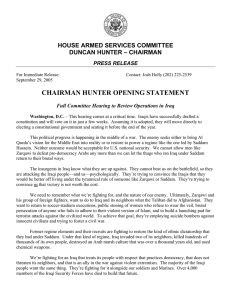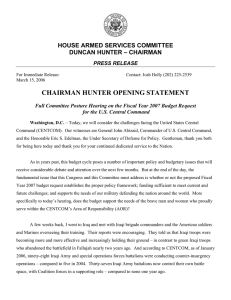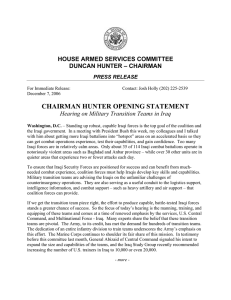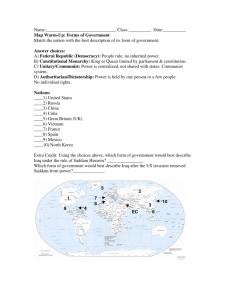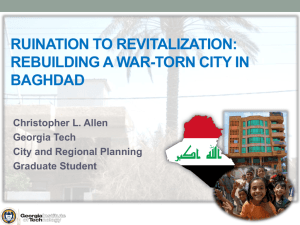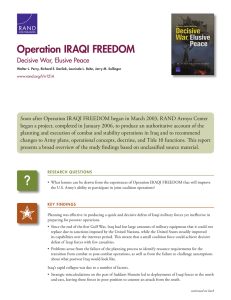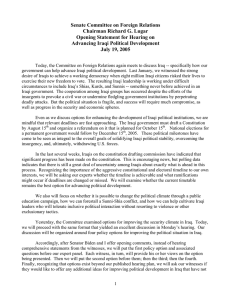6 The RAND Corporation is a nonprofit om
advertisement
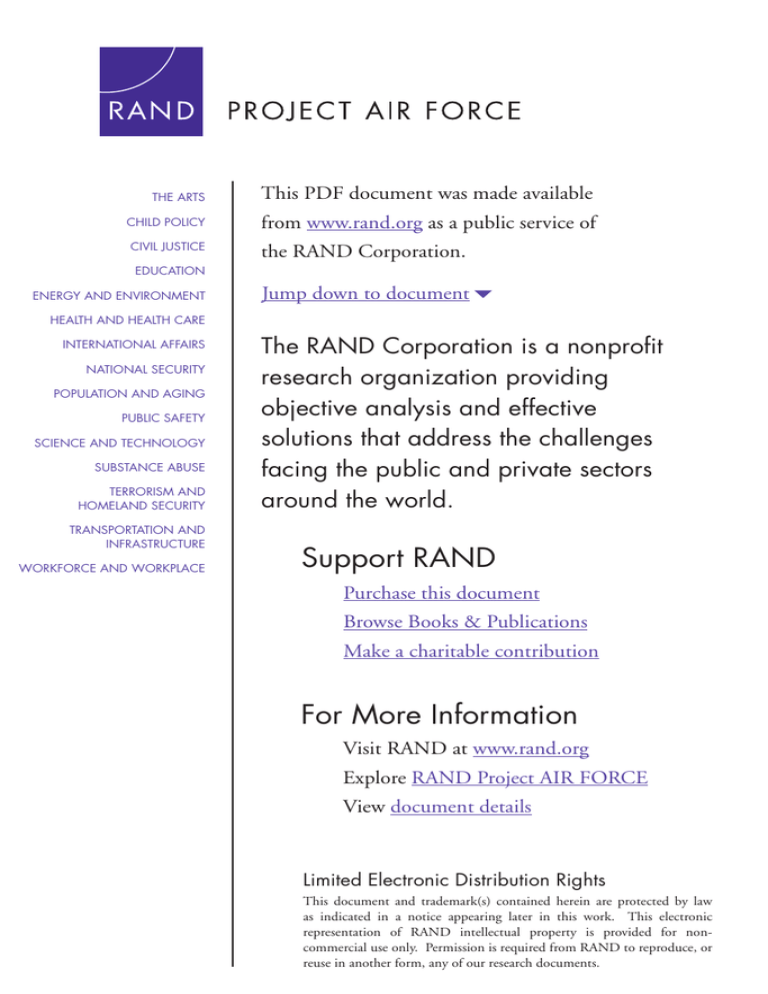
THE ARTS This PDF document was made available CHILD POLICY from www.rand.org as a public service of CIVIL JUSTICE the RAND Corporation. EDUCATION ENERGY AND ENVIRONMENT Jump down to document6 HEALTH AND HEALTH CARE INTERNATIONAL AFFAIRS NATIONAL SECURITY POPULATION AND AGING PUBLIC SAFETY SCIENCE AND TECHNOLOGY SUBSTANCE ABUSE TERRORISM AND HOMELAND SECURITY TRANSPORTATION AND INFRASTRUCTURE WORKFORCE AND WORKPLACE The RAND Corporation is a nonprofit research organization providing objective analysis and effective solutions that address the challenges facing the public and private sectors around the world. Support RAND Purchase this document Browse Books & Publications Make a charitable contribution For More Information Visit RAND at www.rand.org Explore RAND Project AIR FORCE View document details Limited Electronic Distribution Rights This document and trademark(s) contained herein are protected by law as indicated in a notice appearing later in this work. This electronic representation of RAND intellectual property is provided for noncommercial use only. Permission is required from RAND to reproduce, or reuse in another form, any of our research documents. This product is part of the RAND Corporation monograph series. RAND monographs present major research findings that address the challenges facing the public and private sectors. All RAND monographs undergo rigorous peer review to ensure high standards for research quality and objectivity. Why the Iraqi Resistance to the Coalition Invasion Was So Weak stephen t. hosmer Prepared for the United States Air Force Approved for public release, distribution unlimited The research described in this report was sponsored by the United States Air Force under Contracts F49642-01-C-0003 and FA7014-06-C-0001. Further information may be obtained from the Strategic Planning Division, Directorate of Plans, Hq USAF. Library of Congress Cataloging-in-Publication Data Hosmer, Stephen T. Why the Iraqi resistance to the coalition invasion was so weak / Stephen Hosmer. p. cm. Includes bibliographical references. ISBN 978-0-8330-4016-9 (pbk. : alk. paper) 1. Iraq War, 2003– 2. Iraq—Armed Forces—Operational readiness. 3. Iraq— History—1991–2003. I. Title. DS79.76.H68 2007 956.7044'3409567—dc22 2007014369 The RAND Corporation is a nonprofit research organization providing objective analysis and effective solutions that address the challenges facing the public and private sectors around the world. RAND’s publications do not necessarily reflect the opinions of its research clients and sponsors. R® is a registered trademark. © Copyright 2007 RAND Corporation All rights reserved. No part of this book may be reproduced in any form by any electronic or mechanical means (including photocopying, recording, or information storage and retrieval) without permission in writing from RAND. Published 2007 by the RAND Corporation 1776 Main Street, P.O. Box 2138, Santa Monica, CA 90407-2138 1200 South Hayes Street, Arlington, VA 22202-5050 4570 Fifth Avenue, Suite 600, Pittsburgh, PA 15213-2665 RAND URL: http://www.rand.org/ To order RAND documents or to obtain additional information, contact Distribution Services: Telephone: (310) 451-7002 Fax: (310) 451-6915; Email: order@rand.org Summary In Operation Iraqi Freedom (OIF), American forces were able to capture Baghdad and depose Saddam Hussein’s regime within a period of less than three weeks, at the cost of relatively few U.S. killed and wounded. The British units that constituted the other part of the Coalition’s invasion force captured Basra, Iraq’s second-largest city, also with minimal casualties. Drawing upon information derived primarily from interviews with former senior Iraqi civilian and military officials, this monograph focuses on two questions relating to the rapidity and ease of that victory: (1) Why did the vast majority of Iraqi forces fail to offer significant or effective resistance? and (2) Why did the Iraqi leaders fail to adopt certain defensive measures that would have made the Coalition invasion more difficult and costly? The analysis shows that the rapid collapse of Iraqi resistance was due to a combination of the following: • Saddam’s strategic miscalculations and preoccupation with internal threats • the flawed Iraqi strategy, poorly managed and executed battlefield operations, and inferior equipment • the poor motivation and morale of the Iraqi Regular Army and Republican Guard forces • the superior firepower and other warfighting capabilities of U.S. forces. Any one of these shortcomings might have compromised an effective Iraqi defense; collectively, they ensured a monumental rout. ix x Why the Iraqi Resistance to the Coalition Invasion Was So Weak Saddam Made Strategic Miscalculations A key reason for the weak Iraqi defensive performance was Saddam Hussein’s strategic miscalculations about the threat Iraq faced in early 2003. Saddam believed that (1) war with the United States could be avoided, (2) if war occurred, the United States would not invade Iraq, but would confine its operations to limited air attacks, and (3) in the unlikely event an invasion occurred, the Iraqi resistance would be sufficient to cause the United States and its Coalition allies to accept a negotiated political settlement that would leave his regime in power. (See pp. 18–27.) Saddam’s propensity for strategic miscalculation can be attributed to his congenital optimism, excessive self-confidence, and poor understanding of international and military affairs. The erroneous assumptions underlying his decisions went unchallenged because he was surrounded by sycophants and equally uninformed subordinates who were fearful of telling him truths that they believed he did not want to hear. The climate of fear Saddam engendered within Iraq nurtured a culture of lying, whereby senior military officers routinely misled Saddam about the readiness and fighting will of their forces. (See pp. 11–15.) Because Saddam was the dominant decisionmaker in Iraq, his strategic misjudgments shaped Iraq’s political and military behavior in the run-up to and conduct of the 2003 war. By disregarding the potential peril his regime faced after September 11, 2001 (9/11), Saddam failed to take the timely political steps—such as offering immediate and full cooperation to international arms inspectors—that might have helped to fend off a U.S. attack. The Iraqi leader’s misperception of the threat fostered a lack of urgency in Iraqi defensive preparations, which often were ad hoc and last-minute. Saddam’s confidence that the Iraqi military, using the strategy he had mandated, possessed the capability to force a political settlement with the Coalition, even in the event of an invasion, led him to eschew more draconian defensive options, such as the systematic use of scorched-earth and urban-warfare measures, that might have made OIF more difficult and costly for the Coalition. (See pp. 27–29.) Summary xi Saddam Was Preoccupied with Internal Threats Saddam believed that much of the Iraqi military and populace would fight to defend Iraq; however, he trusted neither group as far as his own personal security and that of his regime were concerned. Saddam had been the target of multiple uprisings, coups, and assassination attempts; as a result, he gave priority to the preservation of his personal rule and his own security above all other matters. This overriding concern with internal security measures weakened Iraqi defenses against external attack. (See p. 31.) To escape attacks on his person, Saddam moved frequently, conducted business from a variety of safe houses, refused to use the telephone, and limited information about his movements to a very small circle. To forestall coups, Saddam filled Iraq’s key defense positions and battlefield commands with members of his family and his Tikriti clan, even though such persons often were, at best, only marginally competent in the military arts. He also established multiple competing military and militia organizations, with separate chains of command, in order to guard against anti-regime collusion; strictly controlled all troop and equipment movements in the country; and forbade the deployment of Regular Army or Republican Guard units inside Baghdad. To deter potential uprisings, Saddam positioned military units to prevent the infiltration of insurgent elements from Iran and ordered his security operatives and Ba’ath Party officials to keep close watch over the Iraqi civilian population. (See pp. 32–35.) Saddam’s preoccupation with internal defense made a successful decapitation air strike to remove him problematic. It also reduced the possibility that any “shock and awe” effects created by the simultaneous bombing of dozens of leadership and other key targets would cause Saddam’s regime to “crumble.” However, Saddam’s focus on internal threats also undoubtedly weakened Iraqi capabilities to counter a conventional invasion: It forestalled the adoption of an effective defensive strategy, degraded the quality of Iraq’s military leadership and battlefield decisionmaking, and prevented the coordination and unified command of the Iraqi forces charged with resisting the Coalition advance. (See pp. 36–39.) xii Why the Iraqi Resistance to the Coalition Invasion Was So Weak Iraq’s Military Strategy and Operations Were Poorly Designed and Executed The warfighting strategy that Saddam imposed on his forces did little to effectively support his overarching political-military objectives of protracting the conflict, maximizing U.S. casualties, and thereby creating pressures for a negotiated solution that would leave his regime in place. Indeed, the defensive scheme he adopted hastened Iraq’s defeat by failing to exploit potential options for prolonging the conflict and maximizing Coalition casualties. (See pp. 41–42.) Among other shortcomings, Saddam’s defensive scheme left most of the Iraqi Regular Army divisions in southern Iraq oriented to counter a threat from Iran and not well-positioned to meet an invasion from Kuwait. These units, along with most of the Regular Army divisions situated along the Green Line facing Kurdish-controlled territory in northern Iraq, remained close to their prewar deployment areas throughout the conflict. His decision to have Republican Guard and Regular Army divisions defend Baghdad from distant external defensive locations made those divisions extremely vulnerable to piecemeal destruction by U.S. air and ground forces. The immediate defense of the cities was left largely to politically reliable, lightly armed militias, and to Special Republican Guard units in the case of Baghdad. However, no fixed defenses or barricades were erected in the cities that could have provided strong fighting positions for these forces. Measures that could have slowed the U.S. advance toward Baghdad, such as the systematic mining of roads, destruction of bridges, and flooding of choke points, were not incorporated in the Iraqi defensive scheme. (See pp. 42–55.) Moreover, Iraqi defensive operations were poorly managed and executed. These failures resulted from the Iraqi forces’ inept military leadership, dysfunctional command arrangements and practices, poor situational awareness, counterproductive positioning on the battlefield, and poor training—even in skills as basic as marksmanship. The most egregious example of Saddam’s wrongheaded battlefield management was his April 2nd order to move Iraqi divisions defending against the U.S. forces advancing from the south of Baghdad (which Saddam Summary xiii labeled a “strategic deception”), to the north of the capital in order to meet the “real” attack, which he suddenly concluded would be coming from Jordan. (See pp. 55–74.) Aside from such mismanagement, Iraqi forces were further disadvantaged throughout the conflict by the fact that much of their armor and other military equipment was old and markedly inferior to that of the Coalition. (See pp. 74–76.) Poor Motivation and Morale Decisively Undermined the Iraqi Defense The central reason for the lack of Iraqi resistance in OIF was the Iraqi military’s extremely poor motivation and morale. Events showed that the vast majority of the officers and troops in the Regular Army, Republican Guard, and Special Republican Guard did little if any fighting, and that they mostly deserted their units before being engaged by Coalition ground forces. In the course of the march up to Baghdad, U.S. ground forces rarely confronted cohesive enemy units of even battalion size. When major combat ended, not a single organized Iraqi military unit remained intact, because all the Iraqi troops that had survived the war had “self-demobilized” by going home. (See p. 77.) This lack of fighting will and the high desertion rate were attributable to (1) the harsh service conditions that had depressed morale in Iraqi ranks even before the outbreak of hostilities, (2) the widespread conviction on the part of Iraqi officers and enlisted personnel that resistance against technologically superior U.S. forces would be futile, and (3) the fact that Iraqis of high and low rank saw little, if any, reason to fight and die for Saddam and his regime. The limited resistance that Coalition forces encountered mainly came from Saddam Fedayeen and Ba’athist militiamen, who had a major stake in the regime’s survival, and from foreign jihadists, who were committed to defending a Muslim state against foreign infidels. (See pp. 77–86, 98–104.) Desertions became commonplace, because the threat of eventual punishment that had previously deterred would-be deserters from fleeing their units was no longer credible once it appeared that Saddam xiv Why the Iraqi Resistance to the Coalition Invasion Was So Weak would be overthrown. Senior Iraqi officers no longer attempted to enforce discipline in their units, and they frequently sanctioned and facilitated the desertion of their troops. (See pp. 86–90.) The physical and psychological effects of U.S. air attacks also had a major influence on Iraqi battlefield behavior. The lack of any Iraqi air defense, combined with the precision and lethality of U.S. air strikes, proved devastating to both Iraqi military equipment and troop morale. The prospect of air attacks motivated Iraqi soldiers to stay away from their armored vehicles and artillery, and engendered fears among the troops about their personal survival and the safety of their families. Former Iraqi commanders testified that U.S. bombing prompted massive numbers of their troops to abandon their equipment on the battlefield, desert, and return home. (See pp. 90–97.) The effects of Coalition psychological operations (PSYOPS) on Iraqi morale and behavior are more difficult to gauge. The surrender of Iraqi troops was a principal PSYOPS objective. That comparatively few Iraqis surrendered suggests that PSYOPS effects were limited. However, Iraqi troop behavior did conform to the PSYOPS appeals for desertion and weapon abandonment. The entry of U.S. forces into Baghdad was a major psychological shock to Iraqi military and civilian leaders in the capital, and it quickly undermined any remaining will to resist. When Saddam abandoned Baghdad on April 10, there were no longer any forces in the city for him to command. (See pp. 104–112.) Superior Military Capabilities Gave Coalition Forces an Overwhelming Advantage The Coalition’s domination of the battlefield in OIF was also due to its capability to deploy well-equipped and highly trained and motivated fighting forces. The Coalition’s objective of securing a prompt, lowcasualty takedown of Saddam’s regime was also facilitated by a battle plan that identified Baghdad as the Iraqi regime’s center of gravity and provided for a scheme of maneuver that would allow U.S. forces to seize the capital rapidly. (See p. 113.) Summary xv In virtually every aspect of the fighting, Coalition forces demonstrated a marked superiority over their Iraqi opponents. The discrepancy in capabilities was particularly telling in the virtual immunity of Coalition armor to enemy fire, the ability of Coalition ground and air forces to deliver accurate, lethal fire on Iraqi targets and to attack those targets at standoff ranges and at night. The Coalition’s ability to maneuver ground forces rapidly and sustain them over long distances also undermined the Iraqi ability to mount a coherent defense. (See pp. 113–121.) Be Careful About Drawing Lessons from OIF Military and civilian decisionmakers should be careful not to draw unwarranted lessons from OIF, particularly the notion that high-tech weaponry and communications will inevitably enable smaller-sized U.S. ground forces to be decisive against larger-sized, but less hightech enemy forces in future conflicts. Decisionmakers should also be cautious about extrapolating operational lessons, such as whether invasions can be conducted at minimal cost in U.S. casualties in the absence of extended preparatory air campaigns. The extraordinary battlefield advantages that Coalition forces enjoyed in Iraq during March and April 2003 may not be replicated in future conflicts. (See pp. 124–125.) The Iraqi military proved to be an extremely weak and inept foe in conventional conflict. While many of the Iraqi military shortcomings evident in OIF paralleled those observed 12 years earlier in Operation Desert Storm, the Iraqi military establishment that the Coalition faced in OIF was substantially more debilitated and hollow than was the enemy the United States and its allies faced in 1991. As a consequence, an Iraqi battlefield performance that was poor in 1991 was even worse in 2003. (See pp. 125–128.) The Coalition benefited greatly both from what Saddam Hussein did and from what he did not do in the run-up to and conduct of OIF. The Iraqi leader’s strategic misjudgments, propensity to focus on internal threats, poor defensive schemes and command appointments, xvi Why the Iraqi Resistance to the Coalition Invasion Was So Weak and inept battlefield management significantly weakened the Iraqi military’s capability to mount even a semblance of an effective defense. Indeed, it is difficult to think of other actions that Saddam might have taken, short of unconditional surrender, that would have proven more beneficial to the Coalition cause than the policies and practices that he actually adopted. (See p. 129.) But what Saddam did not do was perhaps even more important. Had the Iraqi leader held a less benign view of the Coalition’s intentions and recognized early on that his regime was in serious peril, he might have adopted scorched-earth tactics, urban-centered defenses, and other courses of action that could have increased the costs of OIF to both the Coalition and to the Iraqi people. (See pp. 129–130.) OIF Paved the Way for the Insurgency That Followed Despite speculation to the contrary, Saddam did not plan for a protracted guerrilla war after an Iraqi defeat in the conventional conflict. There were, however, a number of Iraqi actions before and during OIF that helped facilitate and shape the insurgency that has emerged in Iraq, including the large-scale arming of Ba’athist and other Saddam loyalists, the widespread dispersal of munitions and weapon stockpiles, the release of criminals from Iraqi prisons, the movement into Iraq of thousands of highly motivated foreign jihadists, the recruitment of Fedayeen Saddam militiamen and other persons willing to mount suicidal or near-suicidal attacks against U.S. forces, and the employment of unconventional tactics and weapons that eventually would become the hallmark of Iraqi insurgent operations. (See pp. 131–134.) Importantly, the rise of insurgency in Iraq was also facilitated by the magnitude and nature of the Iraqi collapse, which was marked by the desertion of essentially the entire Iraqi military, security, and governmental structures. This massive flight from duty stations released into the Iraqi countryside numerous military officers and rank-andfile militia fighters, security and intelligence personnel, and Ba’athist officials who possessed the skills, resources, and potential motiva- Summary xvii tion to mount and sustain a resistance against the occupation. (See pp. 133–134.) The massive desertions also deprived the Coalition of the indigenous military forces and civilian officials that Coalition planners had counted on to help stabilize and secure Iraq. The small size of the OIF invasion force magnified the harmful effects resulting from the absence of any compensating indigenous assets. Indeed, without the active assistance of organized Iraqi military and police forces, Coalition troops lacked the numerical strength to promptly stabilize the country, which opened the way for widespread looting and lawlessness that made reconstruction more difficult and costly and undermined public support for the occupation. (See pp. 134–139.) The lessons for future U.S. war planners seems clear: When taking down an enemy government or otherwise invading a foreign land, U.S. forces must be both appropriately configured and sufficiently robust to promptly establish firm control over the areas they occupy, to guard national borders, and to secure enemy arms depots and other sensitive sites. (See pp. 138–139.) Even if the United States had sent larger forces to Iraq and had not disbanded the Iraqi military or banned full members of the Ba’ath Party from government employment, and, indeed, had taken other actions to dissuade potential opposition, such as holding early elections, some degree of armed resistance in Iraq was probably inevitable. However, a substantially larger U.S. military force could have restricted the looting, guarded munitions sites and borders, and significantly dampened the lawlessness that swept over the country. These and other actions aimed at preempting and reducing opposition probably could have prevented the insurgency from gaining as strong a foothold in Iraq as it now enjoys. (See pp. 139–140.) OIF May Influence the Behavior of the United States’ Future Adversaries in Several Ways The overwhelming conventional superiority that U.S. forces displayed in OIF may further encourage countries that consider themselves to be xviii Why the Iraqi Resistance to the Coalition Invasion Was So Weak potential military adversaries of the United States to seek nuclear weapons in order to ward off submitting to coercion or catastrophic defeat by technologically advanced U.S. military forces. In this respect, OIF may constitute an additional spur to nuclear proliferation in countries such as Iran and North Korea. However, OIF also carried another lesson for potential adversaries: that the United States is willing to take military action, including the takedown of hostile governments, to prevent “rogue” states from acquiring or possessing weapons of mass destruction (WMD). The takedown of Saddam’s regime was apparently one of the factors that contributed to Colonel Muammar Qaddafi’s decision to abandon Libya’s WMD programs. (See pp. 140–142.) Another major downside lesson that potential adversaries should draw from OIF is that their armor, mechanized, and infantry forces— even if modernized—cannot effectively fight U.S. ground forces so long as U.S. air forces can gain and exploit air supremacy. To cope with this reality, U.S. adversaries can be expected to attach high priority to devising ways to deny U.S. forces air supremacy or, at least, to reduce the adverse effects of that supremacy. Among other approaches, they are likely to seek capabilities that will upgrade the effectiveness of their own air defenses and improve their ability to deny U.S. aircraft the use of proximate air bases. (See pp. 141–142.) To make aerial attacks less effective and U.S. invasions of their home territories more costly and time-consuming, future adversaries are likely to adopt warfighting strategies that emphasize urban warfare and call for the deployment of heavy, as well as infantry, units in built-up areas, in which they can fight U.S. ground forces from wellprepared positions. (See p. 142.) Potential adversaries may also draw one other important lesson from OIF: the potential political-military utility of possessing a capability to wage insurgent warfare against U.S. invasion and occupation forces. To develop such a capability, adversaries would organize, train, and equip their ground units for guerrilla-style warfare and position hidden weapon and munitions caches throughout their country. Selected members of the public would also be organized, motivated, and trained to support resistance warfare. Potential adversaries may calculate that the very prospect of becoming bogged down in a pro- Summary xix tracted guerrilla conflict might serve to deter U.S. leaders from mounting an invasion. If deterrence failed, then protracted insurgency might be a promising strategy for imposing sufficient costs on the United States to force a withdrawal or an agreement to a political settlement acceptable to the enemy’s leadership. (See p. 142.) Indeed, whenever U.S. ground forces become engaged with hostile elements in future conflicts, they must anticipate the possibility of a guerrilla-type response. In such contingencies, the United States will need forces that are organized, trained, equipped, and culturally sensitized for counterinsurgency warfare—attributes and capabilities that, unfortunately, were lacking in many of the U.S. units that first confronted the insurgent resistance in Iraq. (See p. 143.)
